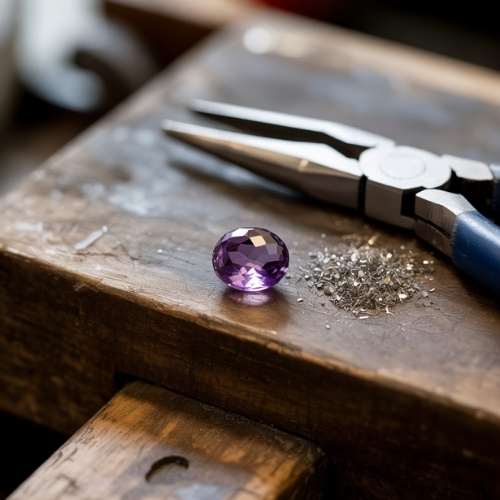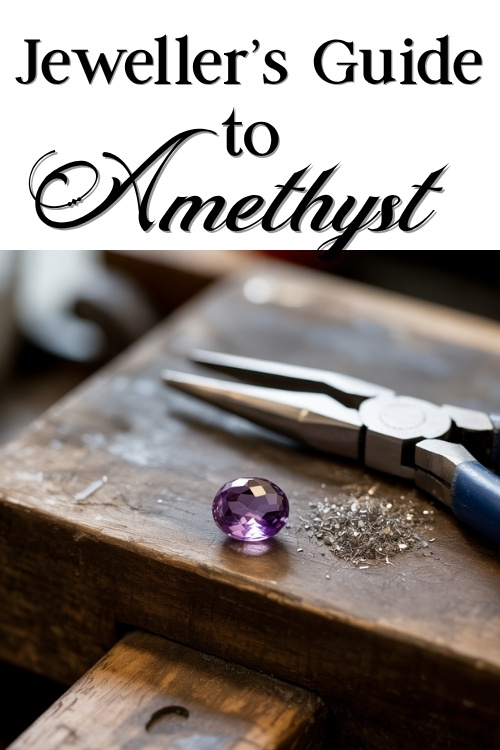Estimated reading time: 5 minutes
Step into the enchanting world of amethyst, a gemstone so steeped in history and beauty, it’s practically royalty. From delicate lilacs to rich, royal purples, this quartz variety has captivated jewellers for centuries with its timeless beauty and versatility. Whether you’re designing everyday pieces or statement jewellery, amethyst offers a harmonious balance of durability and allure.
Jump to:
Basic Identification Information
Name & Synonyms
Amethyst; occasionally called the “sobriety stone.”
Species
Quartz
Colour Range
Pale lavender to deep purple, often with subtle secondary hues of red or blue.
Colour zoning is very common in amethyst, and it can sometimes have a “zebra stripes” look to it.
Refractive Index
1.544–1.553
Birefringence
0.009
Optical Sign
Uniaxial +
Pleochroism
Weak to moderate 2 colours.
Purple, reddish purple
Specific Gravity
2.650–2.655
Fluorescence
None to weak purple or bluish-white under longwave UV light.
Lustre
Vitreous (glass-like and radiant).
Clarity (with GIA clarity type)
Type II
Although eye-clean examples of amethyst are common place, so too are included ones.
Gems Often Mistaken For
Charoite, fluorite, purple sapphire, scapolite, spinel, topaz, tourmaline.
Mohs Hardness
7
Wearability
Good – suitable for everyday jewellery with mindful wear.
Spotting Synthetic (Lab-Grown) Amethyst
Lab-grown amethyst shares the same chemical and physical properties as natural amethyst, which makes identifying it by eye quite challenging. In most cases, you’re not so much spotting obvious signs of synthetic origin as you are noticing the absence of natural traits. While the lack of natural indicators doesn’t conclusively prove a stone is synthetic, if a gem shows no signs you’d expect in a natural specimen, it’s reasonable to suspect it’s lab-grown.
Under magnification, some synthetic amethysts show curved growth lines or inclusions described as “nailhead” or “breadcrumb” patterns. When you see these you can be sure of the stones man-made origins. However, these aren’t guaranteed features, i.e. their absence does not rule out a synthetic origin.
Two other helpful clues include colour and internal structure:
- Colour zoning: Natural amethysts often show uneven colour distribution or zoning. In contrast, synthetic stones tend to be intensely saturated and unnaturally uniform in colour.
- Brazil law twinning: This is an optical pattern frequently observed in natural amethyst. It can often be seen when a gem is angled correctly under a polariscope, and its presence strongly supports natural origin.
Overall, positive identification typically requires gemological tools and experience. When in doubt, it’s best to consult a gem lab or certified gemologist.
Common Treatments
Although not always treated, amethyst is frequently heat-treated to improve or change its colour. Pale stones may be heated to intensify their purple hue or convert to citrine (yellow) or prasiolite (green). These treatments are stable and common in the trade.
Durability & Setting Considerations
Amethyst is a durable gemstone for most types of jewellery, including rings and bracelets. However, its hardness of 7 means it can still scratch or chip if struck against harder surfaces. Take extra care with exposed corners and pointed cuts.
Prolonged exposure to sunlight or intense UV rays can gradually fade the colour of amethyst. Advise clients to remove their jewellery before sunbathing or tanning to preserve vibrancy.
For setting, amethyst responds well to most jewellery techniques. Use protective settings like bezels or recessed prongs in high-wear designs.
Casting in place is risky, as amethyst may fracture under direct flame or rapid temperature change.
🛍️ Explore our selection of pre-owned Amethyst Gemstones for your next jewellery creation.
Care Instructions
Cleaning:
Mild soap and warm water are ideal for amethyst. Use a soft brush to clean around settings.
Ultrasonic cleaning is usually safe, but avoid it for stones with visible inclusions. Steam cleaning is not recommended due to the risk of heat damage.
Storage:
Store separately to prevent scratching. While amethyst is fairly hard, it can still be scratched by harder gems and will scratch softer stones.
Daily Wear:
Well-suited for daily wear in all jewellery types. However, avoid harsh impacts and prolonged exposure to strong sunlight to preserve colour and surface quality.
Market & Ethical Notes
Amethyst remains one of the most widely available and affordable coloured gemstones. Its value is driven by richness and uniformity of colour. Deep, saturated purples without zoning or visible inclusions from natural a source are especially prized.
Major mining locations include Brazil, Zambia, and Uruguay, with many mines following responsible sourcing practices. This makes amethyst a gem that’s both beautiful and relatively low-impact from an ethical standpoint.
🔗 Learn more about the ethical and environmental story behind Reclaimed and Recycled Gemstones.
Symbolic & Spiritual Meanings
Long associated with tranquillity and spiritual insight, amethyst is believed to calm the mind, enhance clarity, and aid in meditation. It’s said to inspire creativity, protect against negativity, and support emotional balance.
The gem is traditionally connected to the crown chakra, making it a favourite among those seeking connection to higher wisdom and intuition.
🔗 Dive deeper into Amethyst Symbolic & Spiritual Meanings
Etymology
The name “amethyst” comes from the Greek amethystos, meaning “not intoxicated.” In ancient times, it was thought to guard against drunkenness and excess. This belief earned it the nickname “sobriety stone,” and amethyst goblets were once popular among nobility hoping to stay clear-headed while drinking.
🔗Curious about how amethyst was viewed in ancient cultures? Explore its fascinating myths and legends
📌 Save this jeweller’s guide to amethyst for quick reference next time you’re working with this stunning gem.


